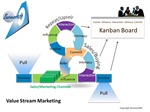One of the best things about developing a Marketing Kanban is it allows you to create a separate cadence for each marketing segment. The old saying is Different Strokes for Different Folks. Why should marketing be any different?
 The Value Stream Marketing diagram symbolizes exactly how important a cadence is. I use a typical Scrum drawing and the 2 iteration circles to highlight the change in cadence for a target prospect when he nears the buying stage and the present customers that need a different type of cadence.
The Value Stream Marketing diagram symbolizes exactly how important a cadence is. I use a typical Scrum drawing and the 2 iteration circles to highlight the change in cadence for a target prospect when he nears the buying stage and the present customers that need a different type of cadence.
What is Cadence? Cadence is determined by the quantity and the frequency that a prospect or customer moves through a marketing cycle. In a true Lean Operation, the prospect/customer should set the pace. A mismatched cadence or when you try to force feed your customer usually will disrupt and sometimes even end the marketing cycle. Creating a smooth or level flow is one of the prime reasons that a Marketing Kanban should be used.
When we create our Value Stream for a prospect/customer we like to calculate our normal marketing cycle time. It differs from takt time which is normally associated with Value stream Mapping. First of all it is not exact, it is an average time. Every customer will be somewhat different. However, I think the surprise is you will see a definite average cycle time (there is an element of variation) that the majority of your prospects take. The more a prospect is qualified the more precise you can become with your cycle time or cadence. On the other hand, the likelihood of getting orders will decrease significantly as you move away from this time.
In Lean, a pacemaker point is used so that we can schedule around one point and create a level flow. In a Marketing Kanban, I like to use the constraint or the bottleneck as my control point. You can argue that you have an external constraint, outside of your marketing. If that is true, then the dollars and resources must  be allocated appropriately. However, I would argue that there is a constraint within your organizations marketing cycle that is limiting your throughput. I believe that dealing with this constraint is easier, less costly and more efficient than dealing with trying to fill the funnel.
be allocated appropriately. However, I would argue that there is a constraint within your organizations marketing cycle that is limiting your throughput. I believe that dealing with this constraint is easier, less costly and more efficient than dealing with trying to fill the funnel.
Having a handle on your control point is not the only part of cadence you need to be concerned about. Your marketing cycle should have a rhythm about it! For example, maybe it takes 2 weeks to fill up a webinar or 3 months for a workshop or auto-responders may be more effective over a 8 week cycle versus a 6 week. Cadences can be changed; they may even be different depending on the company size you are dealing with. The first thing you must do is to determine what it is before trying to make it something else. That’s half the battle.
We have discussed cadence in the sense of a prospect/customer moving through the marketing cycle but there is another important function of cadence. In most outbound advertising media we always discuss frequency. You need to be seen or heard on a consistent basis for your advertising message to work. Ad reps used to tell you that you need 3 or 4 times. Now, I hear that you need 7 or 8 times. That really does not surprise me with the amount of noise that is out there. However, we know the shift is taking place to inbound marketing. Inconsistent inbound strategy is not only ineffective but can be damaging to your organization. A consistent strategy that is easily understood throughout the entire organization needs to be deployed for best results. You must develop a certain cadence to it. If you blog 3 times a week, blog 3 times a week. You could even set-up times to Twitter two times a day. I call them Twitter breaks. If you develop a rhythm or cadence to your efforts it will be easier to build a repore with your community.
As I was looking around for a picture or video to include in this post, I ran across this video. This video is part of the DZone Agile Methodologies Resource Center, sponsored by VersionOne. Click here for additional resources on this topic. In this presentation, Katia Sullivan talks about agile topics like ‘good’ and ‘bad’ cadence as well as the communication gap between business managers and developers/IT. Katia Sullivan is the product specialist at VersionOne. Her expertise is in best practices for agile tooling.
P.S. The take away from this post should be that Cadence is about Consistency and Flow!
Related Posts:
Improve Communication – Have more meetings?
Kanban made easy with Coveys 4Disciplines
Marketing Kanban 102, Work in Process
